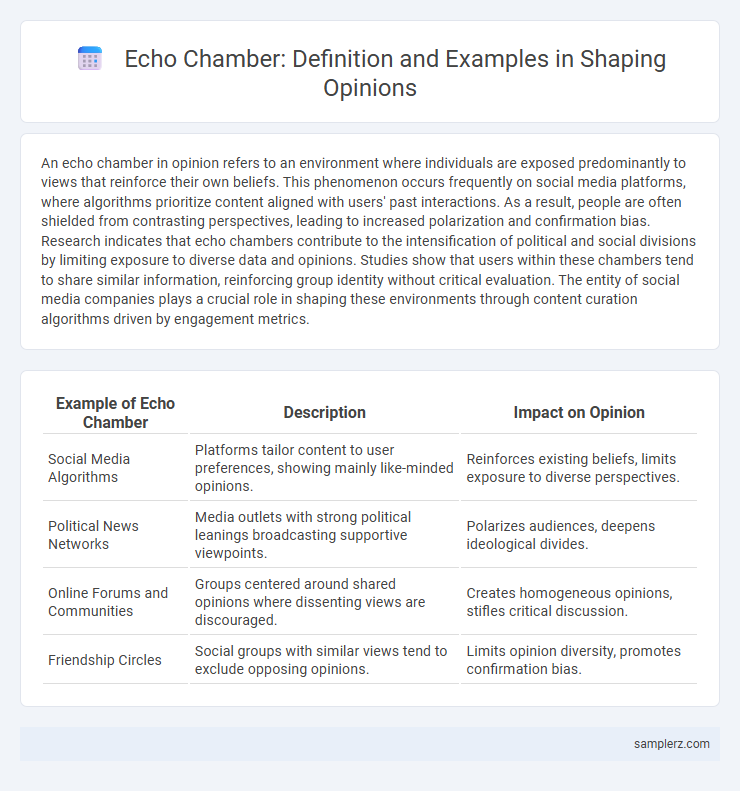An echo chamber in opinion refers to an environment where individuals are exposed predominantly to views that reinforce their own beliefs. This phenomenon occurs frequently on social media platforms, where algorithms prioritize content aligned with users' past interactions. As a result, people are often shielded from contrasting perspectives, leading to increased polarization and confirmation bias. Research indicates that echo chambers contribute to the intensification of political and social divisions by limiting exposure to diverse data and opinions. Studies show that users within these chambers tend to share similar information, reinforcing group identity without critical evaluation. The entity of social media companies plays a crucial role in shaping these environments through content curation algorithms driven by engagement metrics.
Table of Comparison
| Example of Echo Chamber | Description | Impact on Opinion |
|---|---|---|
| Social Media Algorithms | Platforms tailor content to user preferences, showing mainly like-minded opinions. | Reinforces existing beliefs, limits exposure to diverse perspectives. |
| Political News Networks | Media outlets with strong political leanings broadcasting supportive viewpoints. | Polarizes audiences, deepens ideological divides. |
| Online Forums and Communities | Groups centered around shared opinions where dissenting views are discouraged. | Creates homogeneous opinions, stifles critical discussion. |
| Friendship Circles | Social groups with similar views tend to exclude opposing opinions. | Limits opinion diversity, promotes confirmation bias. |
Understanding Echo Chambers in Opinion Formation
Echo chambers in opinion formation occur when individuals predominantly engage with information and perspectives that reinforce their existing beliefs, limiting exposure to diverse viewpoints. Social media algorithms often contribute to this by curating content based on user preferences, intensifying ideological segregation. Understanding echo chambers requires analyzing how confirmation bias and selective exposure drive people to avoid contradictory information, creating polarized communities.
Real-Life Instances of Echo Chambers in Media
Social media platforms like Facebook and Twitter often create echo chambers by algorithmically curating content that reinforces users' existing beliefs, leading to polarized communities. Mainstream news outlets, such as Fox News and CNN, sometimes cater to distinct political ideologies, amplifying biased narratives within their audiences. This fragmentation limits exposure to diverse perspectives, deepening societal divisions and entrenching partisan opinions.
Social Media: Breeding Grounds for Echo Chambers
Social media platforms create algorithm-driven environments that prioritize user engagement by showing content aligned with existing beliefs, reinforcing echo chambers where dissenting opinions are rarely encountered. The constant exposure to homogeneous viewpoints intensifies polarization and limits critical thinking by framing discussions within narrow ideological boundaries. This phenomenon significantly shapes public opinion, often amplifying misinformation and undermining democratic discourse.
Political Echo Chambers: Left vs. Right Perspectives
Political echo chambers reinforce partisan beliefs by filtering information through biased news sources and social media algorithms, limiting exposure to opposing viewpoints. These chambers intensify polarization between left and right perspectives, often amplifying misinformation and reducing opportunities for constructive dialogue. Such environments contribute to ideological segregation, undermining democratic processes and mutual understanding.
How Algorithms Fuel Opinion Echo Chambers
Algorithms on social media platforms amplify opinion echo chambers by prioritizing content that aligns with users' existing beliefs, creating feedback loops that reinforce biases. Personalized recommendation systems analyze user interactions to deliver tailored content, limiting exposure to diverse perspectives. This selective information environment intensifies polarization and diminishes critical discourse.
Celebrity Influence and Echo Chambers in Pop Culture
Celebrity influence often amplifies echo chambers in pop culture by reinforcing homogeneous opinions within fan communities. When high-profile figures publicly endorse specific views, their followers tend to adopt and circulate these perspectives without challenge, limiting exposure to diverse ideas. Social media algorithms further intensify this effect by curating content that aligns with celebrities' positions, deepening the polarization within pop culture echo chambers.
The Role of Online Communities in Reinforcing Beliefs
Online communities often create echo chambers by selectively exposing members to information that aligns with their preexisting beliefs, leading to reinforced opinions and reduced exposure to diverse perspectives. Algorithms used by social media platforms amplify this effect by curating content based on user preferences and engagement patterns. This reinforcement intensifies group polarization and diminishes critical thinking, making it difficult for individuals to challenge their own viewpoints.
Case Study: Echo Chambers During Election Cycles
Echo chambers intensify during election cycles as voters predominantly engage with media and social platforms that reinforce their political beliefs, limiting exposure to opposing viewpoints. Social media algorithms amplify this effect by curating content aligned with users' preferences, creating polarized information bubbles. Studies show that these environments increase partisan division and reduce opportunities for constructive political discourse.
Echo Chambers and the Spread of Misinformation
Echo chambers amplify misinformation by reinforcing users' preexisting beliefs through selective exposure to homogenous content on social media platforms like Facebook and Twitter. Studies show that algorithm-driven news feeds limit diverse viewpoints, increasing polarization and the rapid spread of false information. Understanding the role of echo chambers is crucial in addressing the challenges of misinformation in today's digital landscape.
Strategies to Break Free from Opinion Echo Chambers
Opinion echo chambers reinforce biases by exposing individuals only to homogeneous viewpoints, limiting critical thinking and growth. Strategies to break free include actively seeking diverse perspectives, engaging in open-minded discussions with people holding opposing views, and consuming varied media sources to challenge preconceived notions. Emphasizing empathy and fact-based dialogue fosters intellectual openness and reduces the influence of echo chambers.

example of echo chamber in opinion Infographic
 samplerz.com
samplerz.com